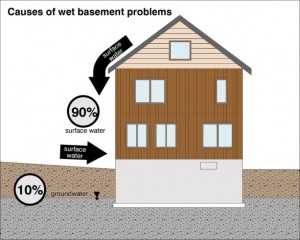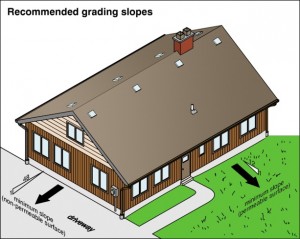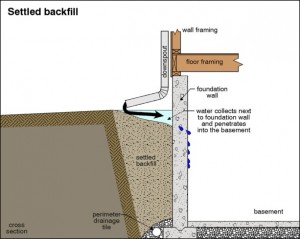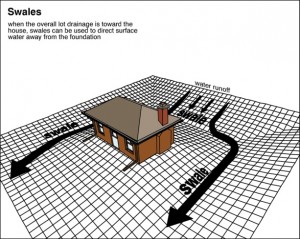When a home is built on land with a high water table, re-grading and gutters are not the correction to the problem. Remember, grading and gutters correct stained, damp or wet walls and, sometimes, minor floor seepage stains. This problem could exist on a portion of one wall, on an entire wall, or on all the walls. It will depend upon the condition of the outside landscaping on the other side of the foundation. Has the house not spoken to you? Are you now confident in being able to recognize these types of situations?
 In a high water table situation the observations will be very different. For example, you might spot that the bottom of wood beam posts in the middle of the basement are soft and rotted. Maybe sections of the concrete floor are cracked, buckled, and pushed up from hydrostatic water pressure. Typically these cracks will have water marks on the edges. You might even see loose vinyl floor tiles, tiles with water marks on the seams, or a brittle crackly noise when you walk on these tiles. If you’re really adventurous, take a small screw driver and pull back carpet corners looking for water damaged wood tack stripping. Can you see a consistent water mark ring on all the walls around the perimeter of the foundation?
In a high water table situation the observations will be very different. For example, you might spot that the bottom of wood beam posts in the middle of the basement are soft and rotted. Maybe sections of the concrete floor are cracked, buckled, and pushed up from hydrostatic water pressure. Typically these cracks will have water marks on the edges. You might even see loose vinyl floor tiles, tiles with water marks on the seams, or a brittle crackly noise when you walk on these tiles. If you’re really adventurous, take a small screw driver and pull back carpet corners looking for water damaged wood tack stripping. Can you see a consistent water mark ring on all the walls around the perimeter of the foundation?
If you can see any of these clues, can you begin to
hear the sound of a flooded basement?
Flooded basements will have the same problems existing on all four walls and over the entire basement floor. The subsurface ground water is coming up into the basement. It is not surface water coming down the sidewalls. There is only one way to correct this situation…install a sump pump and foundation drainage tile.
Do these systems really work? Are they always reliable?
Do they indicate a problem home?
Great questions, next time let’s ask the house.








